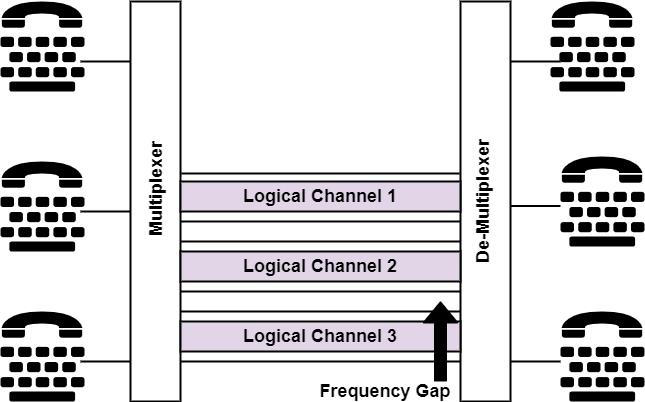
 Data Structure
Data Structure Networking
Networking RDBMS
RDBMS Operating System
Operating System Java
Java MS Excel
MS Excel iOS
iOS HTML
HTML CSS
CSS Android
Android Python
Python C Programming
C Programming C++
C++ C#
C# MongoDB
MongoDB MySQL
MySQL Javascript
Javascript PHP
PHP
- Selected Reading
- UPSC IAS Exams Notes
- Developer's Best Practices
- Questions and Answers
- Effective Resume Writing
- HR Interview Questions
- Computer Glossary
- Who is Who
What is Frequency Division Multiplexing?
Frequency-Division Multiplexing (FDM) is an analog method which is used when the channel's bandwidth is higher than the consolidated bandwidths of the signals which are to be broadcasted.
In FDM, different frequencies are combined into a single composite signal and are transmitted on the channel. At the receiver end, the reverse phase is applied to get the individual frequencies back for working. The entire bandwidth of the channel is divided into logical channels, and each sending device is given with the possession of a logical channel.
There is a gap between the frequencies of adjoining channels to avoid one channel's frequency with that of the other, as shown in the figure below ?

When the signal arrives at the receiver in the composite structure, it has to be disconnected into single signals. This is completed by a device known as a demultiplexer.
Application of FDM
The applications of the Frequency-Division Multiplexing (FDM) are explained below ?
A widespread application of FDM is Amplitude Modulation (AM) and Frequency Modulation (FM), i.e., AM and FM radio transmission. Radios use the air as the transmission channel. A unique band, from 530 to 1700 kHz, is authorised to AM radio. All radio stations are required to send this band.
Each AM station requires 10 kHz of bandwidth. Each station uses multiple carrier frequencies, which represents that it is drifting its signal and multiplexing.
The signal which goes to the air is a sequence of all signals.
A receiver makes all these signals but penetrates (by tuning) only the acquired. Without multiplexing, just one AM station can be communicated to the shared connection, the air.
The situation is similar to FM broadcasting. Here, FM uses a broader band, 88 to 108 MHz, because each station needs more bandwidth, 200 kHz.
The first generation of cellular telephones also uses FDM. Each client has authorised two 30 kHz medium, one for transmitting voice and one for receiving.
The voice signal with a bandwidth of 3 kHz (from 300 to 330 Hz) is adjusted by utilising the FM.

